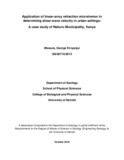| dc.description.abstract | This dissertation presents the results of a ReMi survey conducted in Nakuru Municipality, in Nakuru County, Kenya. Nakuru Municipality is located in the tectonically active rift valley of Kenya with a significantly higher risk of seismic activity.
A 12Km profile was done along the Nairobi-Nakuru-Eldoret highway starting at the Njoro junction and ending at Lanet junction and another short one (1.6Km) running nearly N-S and perpendicular to the 12Km one giving a total of 55 ReMi soundings.
A 2-D model with S-wave velocity ranging from a low of 150m/s to a high of 1000m/s was produced. The low velocities represent loose and mechanically weak material. Higher velocities represent the stiff, well cemented and compact material possessing higher mechanical strength. The area is depicted as having a loose soil cover extending to a depth of not more than 20m. The area to the west has the deepest soil cover that reaches about 15m. The central region only has patches of this material with intermittent outcrops of slightly weathered rock on the surface. The area to the east has slightly more of this loose material. These loose soils are represented by velocities ranging between 150-300m/s. Below these soils is a stiff and denser material from a depth of between 10 and 20m. This dense material, presumed to be weathered rock and cemented pyroclastics is shallower in the central part of the profile, that is, the CBD area. This material is represented by Vs velocities between 400-700m/s and extends to more than 100m in most areas. Values greater than 700m/s are attributed to harder and fairly fresh rock that is mostly mapped in the central part of the profile from a depth of 20m to the deepest reaches of the survey probe at about 100m.
Numerous deep faults were identified as low Vs zones gated by high velocity zones on either sides. These zones recorded velocities in the range of 150-400m/s. The Vs30 for the study area falls between 240 and 680m/s. The range between 240-360m/s places the area to the west in class D, while the rest of the study area falls under class C (Vs30=360-760m/s) according to the IBC. The measured S-wave and P-wave velocities have also been used to derive geotechnical dynamic soil parameters that include the shear and elastic moduli for the entire survey area. | en_US |



